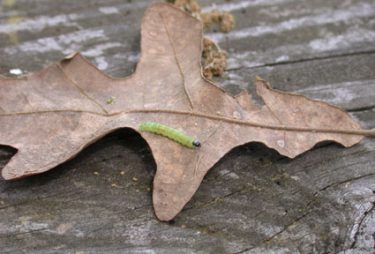
by Matt Lollar | Apr 1, 2021
If you’ve been raking leaves recently, you’ve probably noticed little green worms hanging from the trees. They seem to be in abundance this year and can be found crawling on driveways, just hanging around, and maybe even feeding on oak tree leaves.
These green worms that are all over the yard are oak leafrollers (Archips semiferanus) or oak leaftiers (Croesia semipurpurana). Some people may refer to them as inchworms, however a number of different caterpillars can go by that name. Leafrollers and leaftiers range in length from 1/4″ to 1″. The adult form of these insects is a 1/2″ long moth. The oak leafroller moth is mottled tan and brown and the oak leaftier moth is yellow with brown markings.
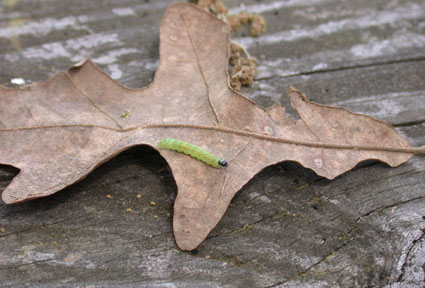
An oak leafroller caterpillar crawling on a leaf. Photo Credit: Blair Fannin, Texas A&M University
In May, the adults of both species lay their eggs in the twigs and leaf buds of a number of tree species. The eggs don’t hatch until March of the following year. When the caterpillars emerge, they feed on the newly forming leaves and flowers of oak, hackberry, pecan and walnut trees. If they are disturbed, they will stop feeding and hang from a strand of silk. Oak leafroller caterpillars pupate in tree branches, while oak leaftier caterpillars drop to the ground and pupate in leaf litter. Adult moths emerge in one to two weeks.
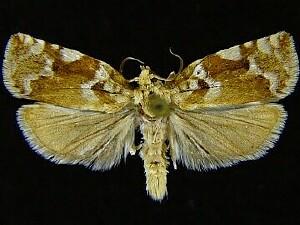
A leafroller moth with wings spread. Photo Credit: U.S. National Museum
The oak leafrollers and oak leaftiers don’t really do enough damage to be considered pests, but they are a bit of a nuisance. Thankfully, birds and parasitic wasps will eat and kill the majority of the population. For in-depth information on most of the interesting insects in your yard, please visit the UF/IFAS Featured Creatures Website.
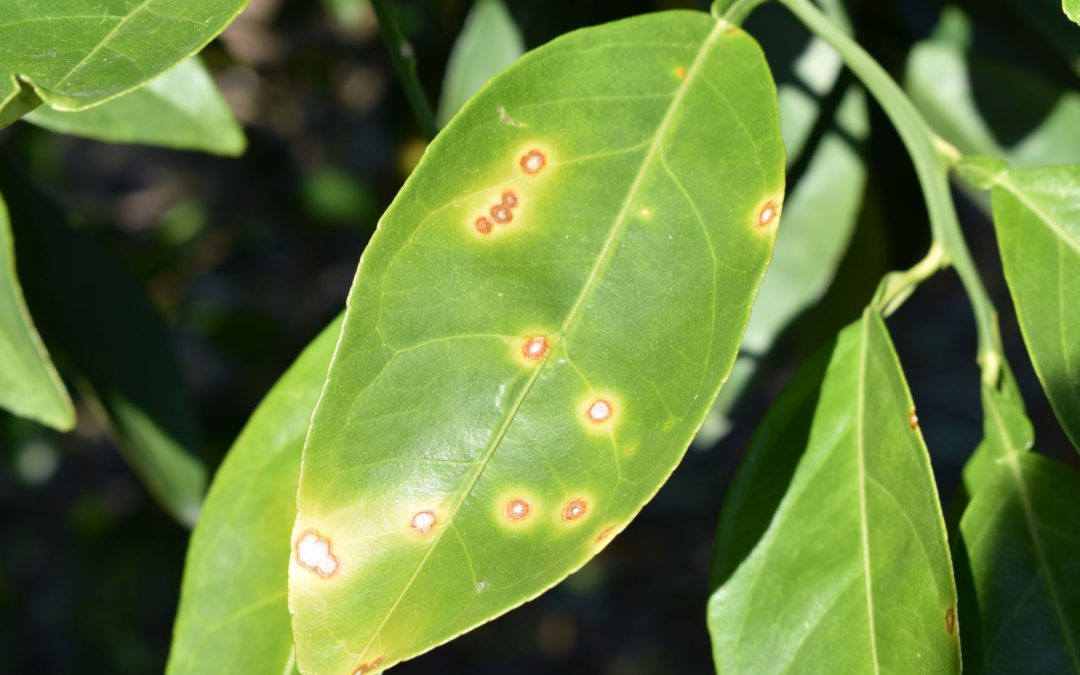
by Mary Salinas | Apr 1, 2021
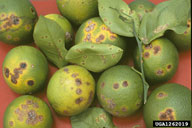
Citrus canker symptoms on twigs, leaves and fruit. Photo by Timothy Schubert, FDACS
Citrus canker was found for the first time in the Florida panhandle in Gulf Breeze in southern Santa Rosa County in November 2013. Since that time, citrus canker has spread widely in the Gulf Breeze area and just recently in 2020 was found in two locations in Panama City and Panama City Beach in Bay County.
Citrus canker is a serious bacterial disease that only infects citrus trees. It will not infect any other plant species nor is it a threat to human health. Severely affected trees experience substantial leaf loss and premature fruit drop and serve as a source for infecting nearby citrus. The disease spreads through wind, rain, and transportation of infected plant material from other locations.
This highly contagious disease has no cure although progression of the disease can be slowed through the use of copper-based products. This publication guides the homeowner on using copper.
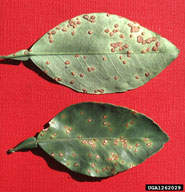
Citrus canker lesions on leaves are raised, rough and visible on both sides of the leaf. Photo by Timothy Shubert, FDACS.
Not all citrus varieties are equally susceptible to this disease. Grapefruit, lemon, and lime are some of the most vulnerable while tangerine and tangelo varieties are among the most resistant.
What should you do if you suspect your citrus is infected with this disease?
- Look at this guide for more information and compare the symptoms on your tree to the photos. Lesions on the leaves penetrate through the leaf so they are visible on the upper and lower leaf surfaces, are rough, and have a yellow halo. The lesions look similar on the fruit and stems. Lesions (or cankers) on the stems usually indicate a longer standing infection of a year or more.
- Consult your local Horticulture Extension Agent to confirm the diagnosis and obtain more information and control/removal strategies.
- Proper removal of infected trees is recommended to prevent the spread of citrus canker but is not mandatory. The best way to dispose of infected trees is through cutting them down and burning them onsite; this ensures than none of the plant material leaves your yard to infect other areas. Consult your local burn regulations before burning. Stray leaves, branches and fruit should be raked and burned or double bagged for the trash. Please avoid disposing of any of your citrus trees by putting them by the side of the road for pickup by the county yard waste recycling or regular waste disposal. The bacterium will survive in the plant tissue and be spread to other neighborhoods in the county. You can, however, double bag infected plant material in sturdy bags and place it in the trash.
For more information please see:
UF IFAS Gardening Solutions: Citrus
Citrus Culture in the Home Landscape
UF IFAS Extension Online Guide to Citrus Diseases
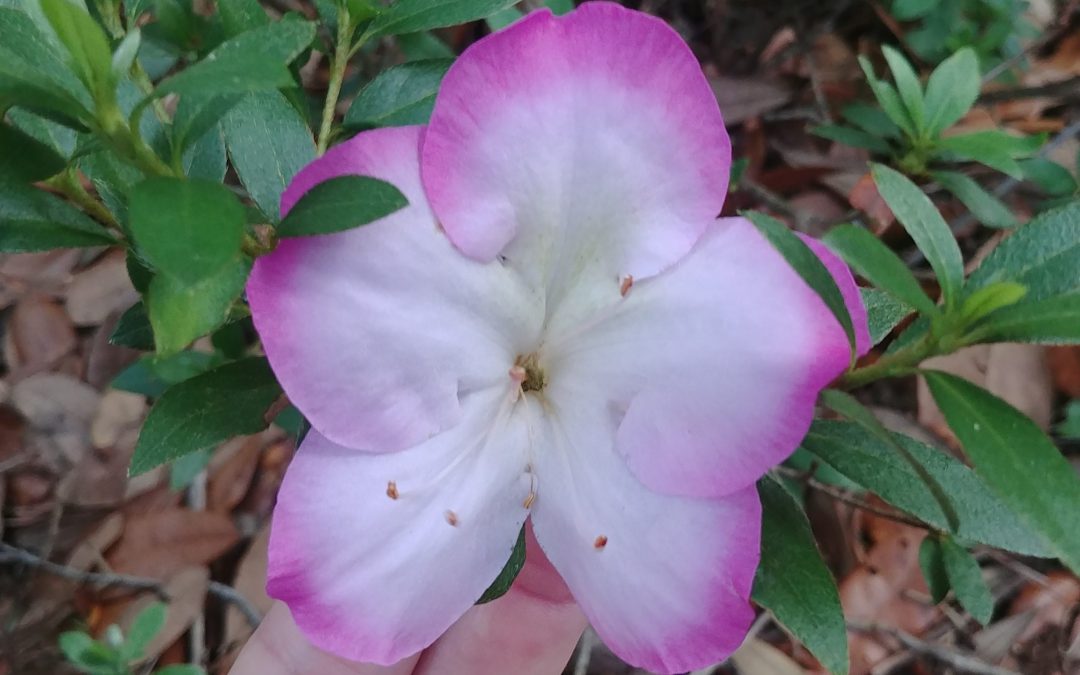
by Matt Lollar | Mar 25, 2021
Article written by Dr. Gary Knox, North Florida Research & Extension Center – Quincy, FL.
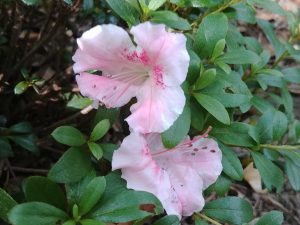
‘Gumpo Pink’ flowers are 3 inches in diameter and are pink with purplish pink dots and occasional white blotches on petals.
Background
In the times before re-blooming azaleas like Encore®, Bloom-A-Thon® and others, Satsuki azaleas were valued for late flowering that extended the azalea “bloom season”. Even with modern re-blooming azaleas, Satsuki azaleas still are appreciated as refined evergreen shrubs for the sophisticated garden or discerning plant collector.
“Satsuki” means “Fifth Month” in Japanese, corresponding to their flowering time in much of Japan. These azaleas were developed hundreds of years ago from their native Rhododendron indicum and R. eriocarpum. The Japanese selected cultivars more for their form and foliage than for flowering. These beloved plants were used in gardens as sheared boxwood-like hedges or pruned into rounded mounds that might resemble rocks or boulders in classical Japanese gardens. Their size and form also made them well adapted for training as bonsai. Most of the Satsuki azaleas in America were introduced in the 1930s by USDA.
Description
Satsuki azaleas are small evergreen shrubs that flower in April and May in north Florida, long after most older type azaleas have finished. Satsuki azaleas also are known for producing large, mostly single flowers up to 5 inches in diameter in colors of white, pink, red, reddish orange and purple. Often the flowers will include stripes, edging, blotches, spots or flecks of contrasting colors (Sometimes all on the same plant!) with more than 20 different color patterns recorded.
Satsuki azaleas have an elegant subtle charm, quite unlike the flashy, over-the-top, heavy blooming all-at-once Southern Indica azaleas like ‘Formosa’ and ‘George L. Taber’. Typically, Satsuki azaleas display a few large blooms at a time, allowing one to better appreciate their size and color patterns as contrasted against their fine-textured, dark green leaves. To make up for a less boisterous display, Satsuki azaleas flower over a longer timeframe, averaging about 8 weeks, with some flowering an amazing 14 weeks. In another contrast, most Satsuki azaleas grow smaller in size, in my experience reaching about 3 feet tall and wide in a five-year timeframe. The rounded to lance-shaped leaves of Satsuki azaleas also are demure, ranging in length from just ½ inch to no more than 2 inches.
Culture
Satsuki azaleas enjoy the same conditions as most other azaleas: light shade and moist, rich, well-drained soil. Mulch regularly to maintain organic matter and help hold moisture. Fertilize lightly and keep the roots evenly moist. Minimal to no pruning is required. Satsuki azaleas also are well adapted to container culture. Their small size and fine textured leaves make these a favorite for bonsai enthusiasts since their small leaves, branching habit and mounded form naturally make them look like miniature mature “trees”.
Sources and Cultivars
Look for Satsuki azaleas in spring at garden centers or year-round at online nurseries. There are hundreds of cultivars but some popular types to look for include:
Gumpo Pink – 3-in. diameter light pink flowers with purplish pink dots and occasional white blotches
Gumpo White – 3-in. diameter white flowers with occasional pink flakes and light green blotches
Gyokushin – 3-in. diameter flowers are predominantly white but with light to dark pink dots and blotches
Higasa – flowers are 4 to 5 inches in diameter and are purplish pink with purple blotches
Shugetsu – also called ‘Autumn Moon’, 3-in. diameter flowers are white with a broad, bright purplish-red border
Tama No Hada – flowers are 4 to 5 inches in diameter and are white to pink with deep pink stripes; usually flowers in fall as well as spring
Wakaebisu – 2.5-in. diameter flowers are “double” (hose-in-hose) and are salmon pink with deep pink dots and blotches; this also flowers in fall as well as spring
References:
Chappell, M. G.M. Weaver, B. Jernigan, and M. McCorkle. 2018. Container trial of 150 azalea (Rhododendron spp.) cultivars to assess insect tolerance and bloom characteristics in a production environment. HortScience 53(9-S): S465.
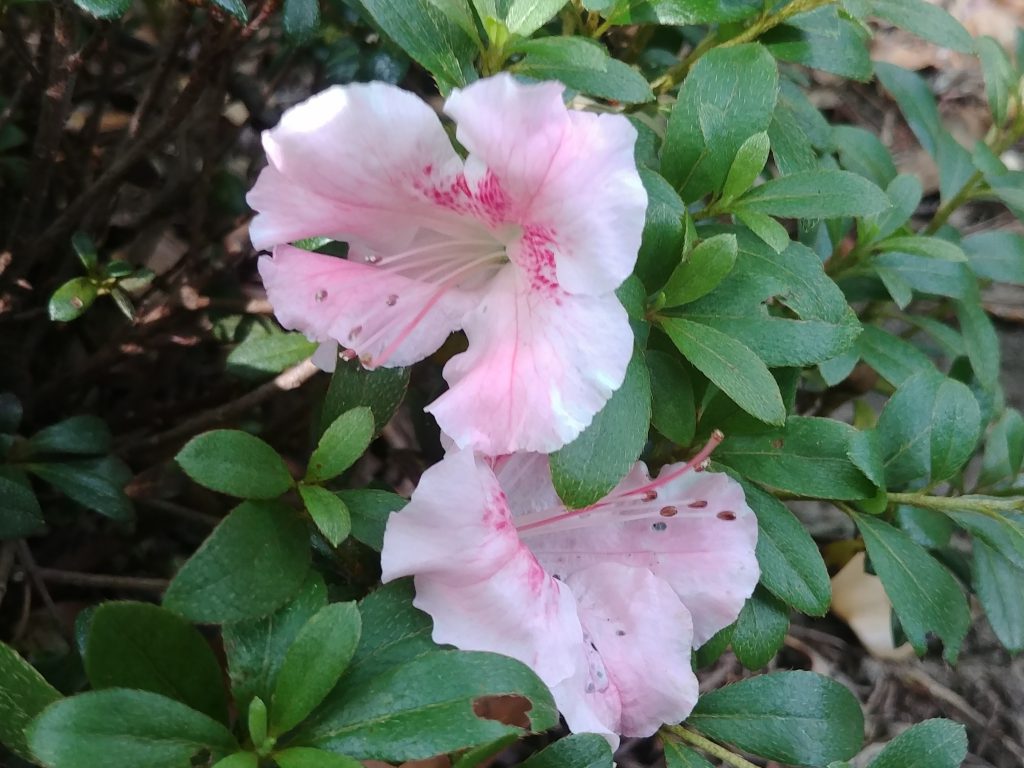
‘Gumpo Pink’ flowers are 3 inches in diameter and are pink with purplish pink dots and occasional white blotches on petals.
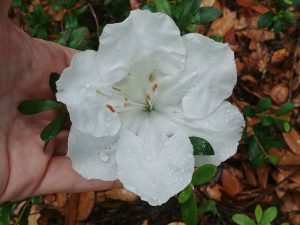
‘Gyokushin’ flowers are white with occasional pink flecks and light green blotches.
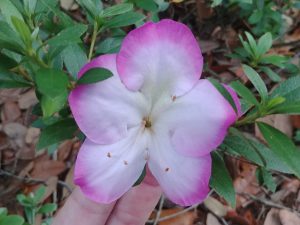
‘Shugetsu’ has 3-inch flowers that have bright purplish-red border on edges of petals.
Galle, Fred C. Azaleas. 1985. Timber Press, Portland, Oregon. 486 pp.
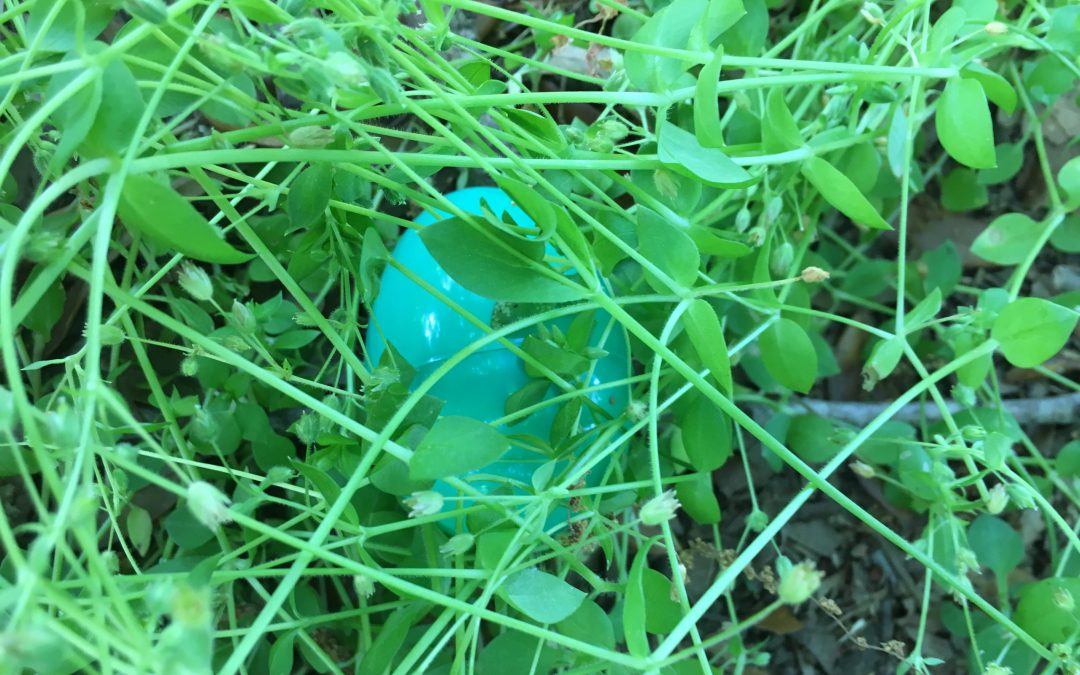
by Larry Williams | Mar 25, 2021
As a boy in a small town in Georgia we had a St. Augustinegrass lawn. My dad started the lawn before I was born. That lawn was still doing fine when I left for college at age seventeen. I don’t remember weeds in the lawn during summer months. I do fondly remember winter “weeds” in that lawn.
To see clumps of winter annuals in our yard and in neighbors’ yards was a natural part of the transition from winter to spring. They added interest to what
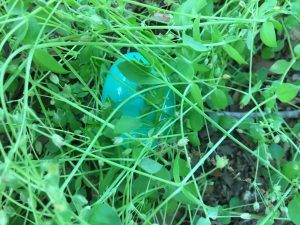
Blue Easter egg hidden in chickweed. Photo credit: Larry Williams
would have been a plain palette of green. It was expected to see henbit with its square stiff stems holding up a display of small pinkish purple flowers in late winter and early spring. A clump of henbit was a great place to hide an Easter egg, especially a pink or purple one.
Wild geranium, another common winter annual, offered another good hiding place for Easter eggs with its pink to purple flowers. Large clumps of annual chickweed would nicely hide whole eggs. Green colored eggs would blend with chickweed’s green leaves.
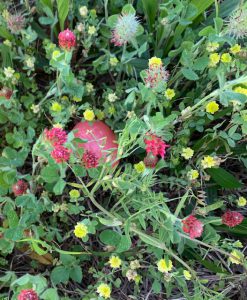
Pink Easter egg hidden in crimson clover & hop clover mix. Photo credit: Larry Williams
Crimson clover with its reddish flowers, hop clover and black medic with their bright yellow flowers were good hiding places for Easter eggs. Plus clovers add nitrogen back to our soils.
I never remember my dad using any weed killer, he rarely watered. The lawn was healthy and thick enough to be a deterrent to summer weeds. But during fall and winter as the lawn would naturally thin and go dormant, winter annual weeds would run their course.
I’ve heard that the sense of smell provides our strongest memories. I remember the first mowing of the season with the clean smell of chlorophyll in the spring air. It was refreshing. Once mowed and as the heat took its toll, by late April or mid-May, these winter annual weeds were gone. What was left was a green lawn to help cool the landscape as the weather warmed. The lawn was mowed high as St. Augustine should be, played on and typically not worried with.
Most people have winter weeds in their lawns that let us know spring is near. Perhaps we worry too much with these seasonal, temporary plants that may have wrongly been labeled as weeds. Besides, how long have we been doing battle with these weeds and they are still here. Most lawns have countless numbers of winter annual seeds awaiting the cooler temperatures and shorter days of early winter to begin yet another generation. By May they are gone.
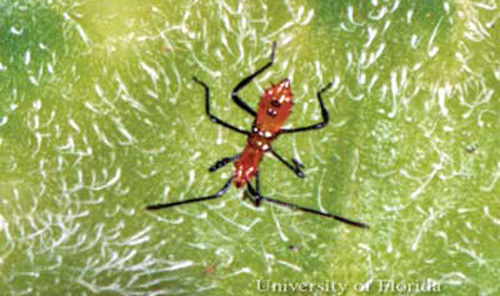
by Matthew Orwat | Mar 25, 2021
Stinkbugs and their relatives are not always problematic in the flower or vegetable garden, but when they become so, they can suck the life out of our fruits and vegetables, create ugly abrasions, and destroy flowers such as roses.
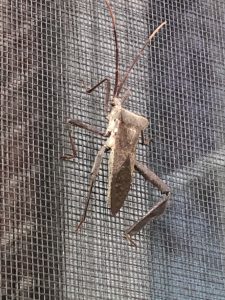
Over-wintering adult leaffooted bug emerging from hibernation . Image Credit Matthew Orwat, UF / IFAS Extension
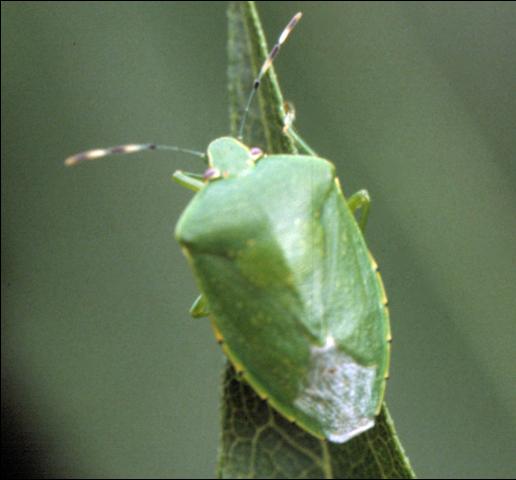
The green stink bug Acrosternum hilare (Say). Image and caption credit EDIS, Dr. Russ Mizell
What is a Stink Bug?
The stink bug (Pentatomidae family) is a major garden pest of a variety of fruits and vegetables including squash, peppers, tomatoes, peaches, plums, pecans and a variety of other edibles. They are known as a “piercing and sucking” insect because that’s the way they feed, by using their mouth, or proboscis, just like a needle to pierce the fruit and suck out the juices. This feeding leaves a damaged area of the fruit which may develop discoloration, rot or fungal disease and render the fruit unsaleable or inedible.
Who are “their relatives”
The leaf footed bug, Leptoglossus phyllopus (L), is a relative of the stinkbug and feeds in the same way, has a similar lifecycle and causes similar damage. They are usually slightly larger and have “leaf like” appendages on their legs which are their namesake.
What is their lifecycle?
In Florida, overwintering adult stink bugs will place a clutch, or tight group of eggs, on a host plant early in the growing season. If their preferred plant is not available, they use a variety of weeds and grasses to lay eggs upon and provide food for their young. After eggs hatch, they go through several nymph stages before they finally reach the adult stage. Stink bugs have multiple generations in a year, often four to five. They readily move to find preferable food sources and might appear in a garden without warning to feed and cause destruction.

Nymph of the leaffooted bug, Leptoglossus phyllopus (L.). Photograph by Lyle J. Buss, University of Florida.
How are they best controlled?
First of all, many stink bugs use weeds as host plants to gather and feed upon, so controlling weedy plants around vegetable and fruit gardens might limit their numbers. If stink bugs are a major problem, planting trap crops, such as sunflowers, is beneficial. Stink bugs prefer to feed on sunflowers more than some other vegetables. This situation can be used to the gardener’s advantage by mechanically killing or spraying stink bugs on trap crops while avoiding treating food crops with pesticides. More information on trap cropping can be found here.
Additionally, stink bug traps are available. These mechanically trap stink bugs, thus reducing their numbers in the garden, but need to be monitored and serviced regularly. Several species of parasitic Tachinid flies are also predators of stink bugs. These flies lay their eggs on adult stink bugs. The fly larva use the bug as a buffet, slowly killing the bug.
Stink bugs are difficult to control with insecticides, but some measure of control can be achieved at their nymph stage with various approved fruit and vegetable insecticides containing pyrethrins. These products are readily available at local garden centers and feed & seed stores.
For more information, please check out the following resources:

















